May 2009
02May2009: Indonesia - IYA2009
Indonesia Post - IYA2009 ~ Astronomy issue
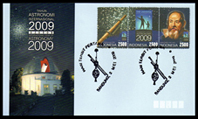
FDC featuring the standard 2500 (IDR) valued stamps. Cache art of Bosscha Observatory at night.
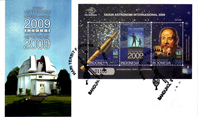
FDC featuring the souvenir sheet (3x 5000 IDR.) Cache art of Bosscha Observatory in daylight.
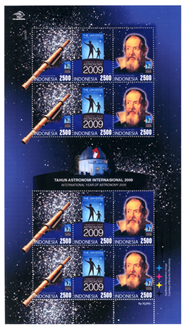
Full sheet of 12 stamps valued at 2500 (IDR) each. Three stamp designs, in an overall se-tenant form. Leftmost stamp features a telescope, rightmost stamp a portrait of Galileo and the center stamp carries the IYA2009 logo. The r/h and l/h stamps also carry the logo in a smaller size. Upper group of six stamps is separated from the lower group of the same number by an image of the Bosscha Observatory.
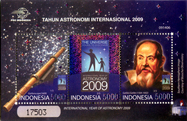
Souvenir sheet (3x 5000 IDR) carries the same stamp designs embellished with reflective additions. Note the increase in value and the small image of the Bosscha Observatory in the lower right of the sheet.
04May2009: Andorra (French Post) - Europa issue
LaPoste - Europa 2009 ~ Astronomy issue: one stamp (0.56 €) depicts a very colorful region of the night sky.
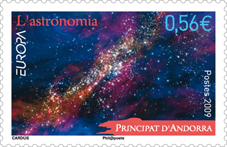
One stamp (0.56 €) design featuring a star field which this writer has yet to identify - your suggestions welcomed.
04May2009: Cyprus - EUROPA issue
Cyprus Postal Services - Europa 2009 ~ Astronomy issue

Booklet front cover with a story relating the mythology regarding the two constellations featured on the stamps.
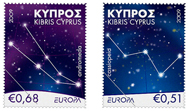
Two designs, both are constellations derived from mythology. The ¤0.51 value features Cassiopia and the € 0.68 value features Andromeda.
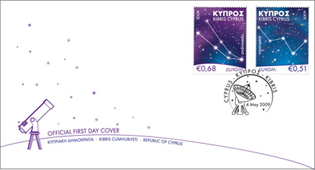
FDC with both Cyprus stamps with special cancel discreetly applied - cleanly struck while sufficient enough to "kill" the stamps without obliterating the designs (a preferred scenario with most philatelists) and cache art featuring a telescope and stars.
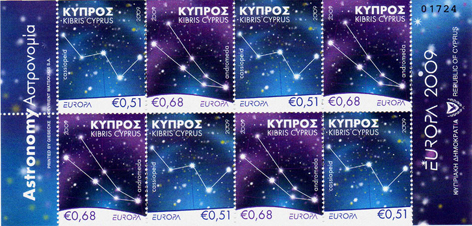
Booklet of stamps carries 8 stamps (4x 2 designs.)
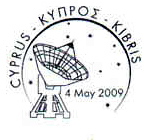
Special postmark used for FDCs.
04May2009: France - EUROPA issue
La boutique du timbre - La Poste Timbre - Europa 2009 ~ Astronomy issue
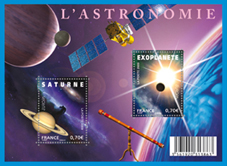
One souvenir sheet (2x 0.70 €) one stamp depicts Saturn, the Horsehead Nebula and a galaxy while the other depicts a star being transited by an exoplanet. Also depicted are an ancient telescope and an orbiting telescope with unknown planets and a moon completing the background design.
04May2009: Monaco - EUROPA issue
Office des Emissions de Timbres Poste de Monaco - Europa 2009 ~ Astronomy issue
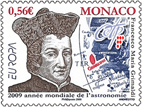
Stamp valued at 0.56€ features Italian physicist and mathematician Francesco Maria Grimaldi (1618-1663), he was the first to describe the diffraction of light. Grimaldi drew an accurate map of the Moon whose nomenclature is still used by astronomers. The Grimaldi crater on the Moon is his namesake and is featured on the stamp (in red) on the partial map of our celestial neighbor.
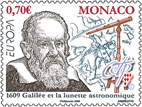
Monaco stamp valued at 0,70€ whose design features a portrait of Galileo Galilei (1564-1642) and his telescope that overlay a partial celestial map depicting constellations of the zodiac. Galileo was an italian physicist and astronomer whose improvements to the telescope in 1609 and consequent astronomical observations are two of the primary foci of the IYA2009 celebration. His support for the view of a heliocentric solar system got him into trouble with supporters of geocentrism and placed under house arrest by the Roman Catholic Church.
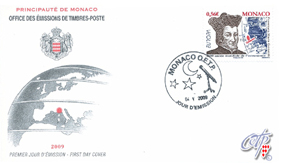
Grimaldi FDC with special FDI cancel featuring telescope, stars and crescent moon. Cache art depicts partial globe with the location of the issuing entity marked in red.
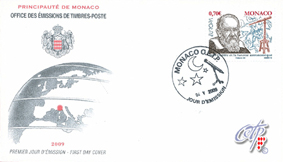
Galileo FDC with special FDI cancel featuring telescope, stars and crescent moon. Cache art depicts partial globe with the location of the issuing entity marked in red.
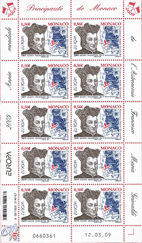
Monaco, full sheet of Grimaldi stamp - one value (x10)
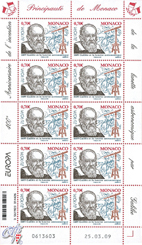
Monaco, full sheet of Galileo stamp - one value (x10)
05May2009: Estonia - EUROPA issue
Estonian Post Ltd. - Europa 2009 ~ Astronomy issue
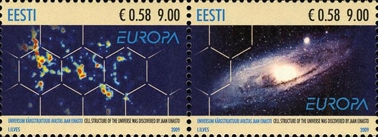
Two stamp designs, both valued at 9.00 EEK (¤ 0.58) that celebrate the discovery of the "cell structure" by Estonian astrophysicist Jaan Einasto. The theory was presented by Jaan Einasto and his colleagues at an international symposium on astronomy in Tallinn in 1977. The theory proposed a new vision of the universe as being shaped in a regular structure of cells that could be likened to that of a honeycomb. (I am open to suggestions regarding the images presented on the two designs.)
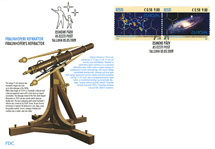
FDC carrying a se-tenant pair of stamps, FDI postmark and cache art of a telescope with descriptive text. Note the postmark design based on the IYA2009 logo.
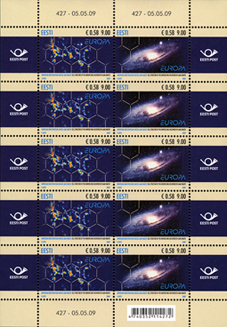
Full sheet from Esti Post of their EUROPA 2009 releases.
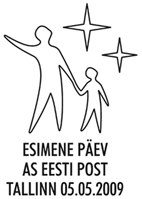
FDI special postmark based on IYA2009 logo
05May2009: Northern Cyprus (Turkish Post) - EUROPA issue
Europa 2009 ~ Astronomy issue: Cyprus (Turkish post)
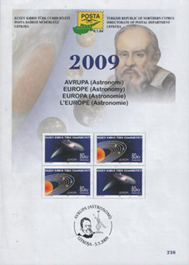
Collector's sheet with four stamp block. Illustrated with image of Galileo, Jupiter and the four moons discovered by Galileo. Also depicted is the special FDI cancel used.

Two stamp designs (2x 0.80 YTL) one with galaxy M81(?) and a comet and the other displaying a diagram of a solar system. NOTE (taken from http://europa-stamps.blogspot.com) : "the stamps issued by the Turkish Republic of Northern Cyprus aren't recognized on an international level, not by the UPU nor by PostEurop. But as most Europa stamps collectors collect those stamps anyway, I decided to publish them on my blog, from now on, even if they aren't official stamp issues." ... they are included here for the same reasons. And to provide a visual reference of "philatelic" items available to the collector. "Authenticity" has been and remains an issue within the realm of philately.
05May2009: Poland - EUROPA issue
The Polish Post - Europa 2009 ~ Astronomy issue
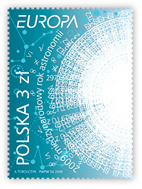
EUROPE 2009: The International Year of Astronomy issue from Poland denominated at 3 PLN.
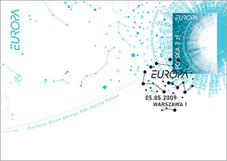
FDC with special FDI postmark and appropriate cache art.
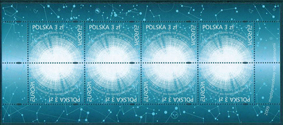
Sheet of eight stamps. The design of the stamp is meant to represent a star that is emitting rays. In this case the star is comprised of very long sequences of digits which speaks toward "modern" astronomy and the streams of data used to represent our cosmic companions. This "digital" image overlays a field that contains numerous diagrams of constellations which speaks toward our "ancient" and early interaction with the heavens. These diagrams extend into the selvage area of the sheet to complete the overall design. Notice how the arrangement of the stamps within the sheet form a circular design element spanning the pairs. In philately this arrangement is known as "tête-bêche" and is a joined pair of stamps in which one is upside-down in relation to the other produced intentionally or accidentally.
05May2009: Russia - EUROPA issue
Publishing and Trading Centre "MARKA" - Europa 2009 ~ Astronomy issue
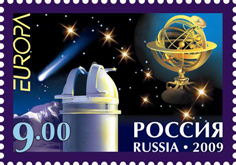
Russia has issued one stamp (9.- RUB) in a mini sheet of 9 stamps depicts an observatory, armillary sphere, night sky with big dipper and a comet. The mini sheet features numerous near and deep field objects in the selvage.
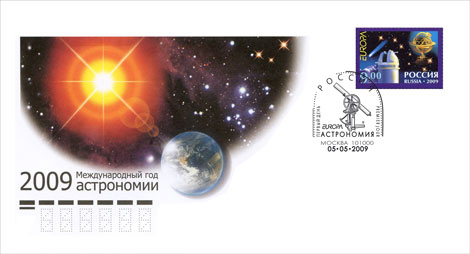
Russian FDC with appropriate cache art.
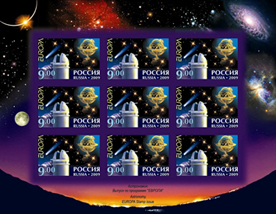
Russian mini sheet of 9 stamps. It depicts numerous near and deep field objects and events in the selvage including a solar eclipse, the Moon, a galaxy and nebulae.
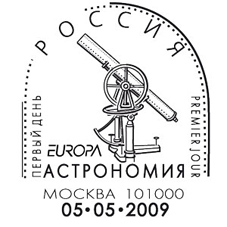
Postmark from FDC of russian issue - depicting a telescope. Note the "dome" shape containing the telescope, reminiscent of an observatory.
05May2009: Serbia - EUROPA issue
PTT Communications "Srbija" - Europa 2009 ~ Astronomy issue:
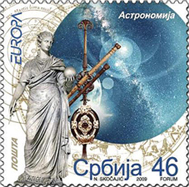
Serbia - Europa 2009 ~ Astronomy issue: The 46 RDS value carries an image depicting a sculpture of "Urania" muse of astronomy. Also pictured are an ancient telescope along with an image of a star field, all of which overlay an ancient diagram of the solar system and a celestial map.
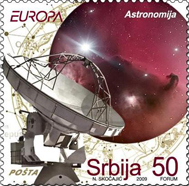
Serbia - Europa 2009 ~ Astronomy issue: The 50 RDS value depicts a modern radio dish and an image of the horsehead nebula (in the constellation Orion) again in a design where they are overlaying historical diagram and celestial map.
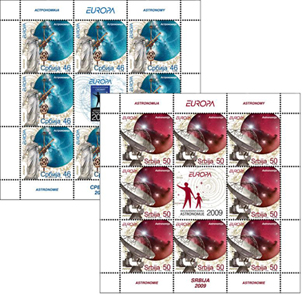
Serbia - Astronomy issue: two stamps (46.- & 50.- RSD) both stamps are issued in mini-sheets of 8 stamps + 1 vignette. Vignette differs according to images presented but both are based on IYA2009 logos.
06May2009: Czech Republic - EUROPA issue
Česká pošta - Europa 2009 ~ Astronomy issue: 400TH Anniversary of Kepler's laws
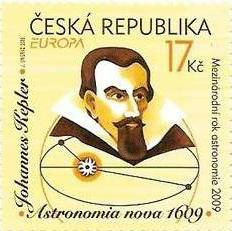
Czech Republic - Europa 2009 ~ Astronomy issue: 400TH Anniversary of the publication of Johannes Kepler's Astronomia Nova. The stamp depicts Kepler and one of his illustrations.
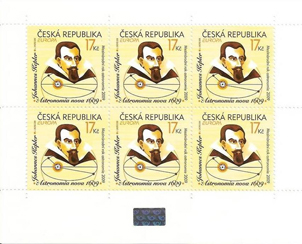
Czech Republic - mini sheet.
06May2009: Finland - EUROPA issue
Posti - Europa 2009 ~ Astronomy issue
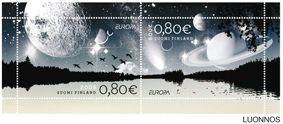
Finland - Europa 2009 ~ Astronomy issue 2 x 0.80 se-tenant pair. "The pair of stamps depict a fantasy landscape of lakes and different heavenly bodies. The left-hand stamp has the Moon in the centre, with the Milky Way on the right side of the stamp. The stamp on the right bears a comet on its left side, accompanied by a [solar] eclipse. The large planet shown on the stamp is Saturn." quoted text courtesy of Posti
06May2009: Macedonia - EUROPA issue
Macedonian Post - Europa 2009 ~ Astronomy issue
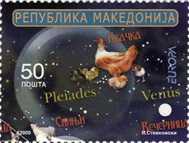
Macedonia - Europa 2009 ~ Astronomy issue: Two stamps (50.- & 100.- MKD) and one souvenir-sheet (150.- MKD) The 50 and 100 values are issued in two sheets of 9 stamps. The stamps depicted show a field of stars with some constellations marked and named, along with some stars and other celestial features. The star fields are overlaid with images taken from Macedonian folklore tradition. This image depicts the 50 MKD value.
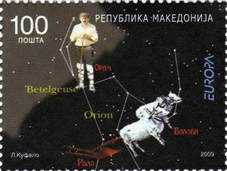
Macedonia - Europa 2009 ~ Astronomy issue: This image depicts the 100 MKD value.
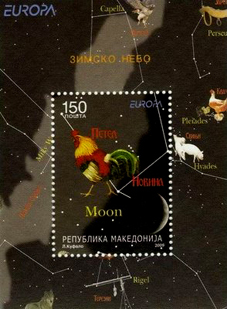
This image depicts the 150 MKD value souvenir sheet.
06May2009: Romania - EUROPA issue
ROMFILATELIA - Europa 2009 ~ Astronomy issue
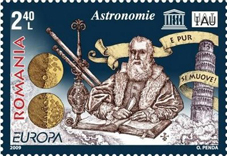
Romania - Europa 2009 ~ Astronomy issue: two stamps (2.40 & 9.10 RON) with the 2.40 value (shown here) depicting illustrations of Galileo, the Moon, a telescope and the Leaning Tower of Piza. Both stamps are issued in 2 types of souvenir-sheets of 4 stamps (2 stamps of each). The position of both stamps is different in each souvenir-sheet. Both stamps are also issued as mini-sheets of 6 stamps with an illustrated margin and is numbered in red. Also available are maxi cards, FDCs and a very limited edition of engravings (signed by the artist) and accompanied by a pair of the stamps.
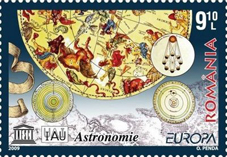
Romania - Europa 2009 ~ Astronomy issue: The 9.10 value stamp (shown here) depicts a variety of astronomical diagrams as well as a portion of a celestial map.

Romania - Europa 2009 ~ Astronomy issue: This image depicts the postmark used for the FDCs.
07May2009: Germany - EUROPA issue
Deutsche Post - Europa 2009 ~ Astronomy issue
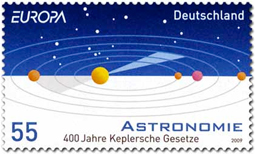
Germany - Europa 2009 ~ Astronomy issue: one stamp (0.55 ¤) honoring the 400th anniversary of the publication of Johannes Kepler's "Astronomia Nova" that contained his first two laws of planetary motion.
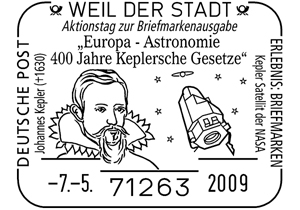
One of the postmarks used on FDCs from Germany. This one carries an image of Kepler and the space telescope that bears his name.
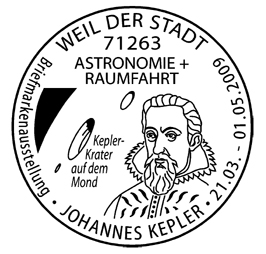
Another of the postmarks used on FDCs from Germany. This one carries a portrait of Kepler and drawing of his lunar crater namesake.
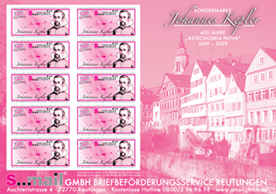
Private printing from Germany valued at 1,43 EURO depicting Johannes Kepler and a diagram of the solar system. This private issue preceded the Deutsche Post issue by several months and was issued to also commemorate the 400th anniversary of the publication of Kepler's "Astronomia Nova." These "customized" stamp formats have been gaining in popularity in recent years and are available through many national postal authorities websites. It opens the possibilities up for the creation of personal philatelic items that would have a very narrow run. It is not clear yet how the the mainstream philatelic community will "value" these "vanity"stamps.
07May2009: Iceland - EUROPA issue
Postphil Iceland - Europa 2009 ~ Astronomy issue
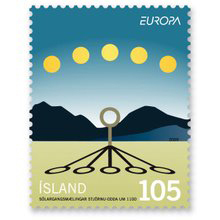
Iceland - Europa 2009 ~ Astronomy issue: Two stamps issued, one stamp valued at 105 ISK (pictured here) and one stamp valued at 140 ISK.
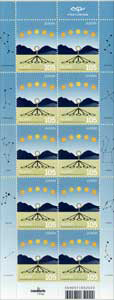
Iceland 105 value mini sheet with constellations in the selvage area.
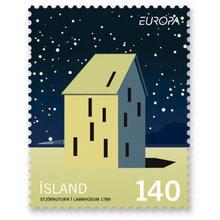
Iceland - Europa 2009 ~ Astronomy issue: Two stamps issued, one stamp valued at 105 ISK and one stamp valued at 140 ISK (pictured here.)
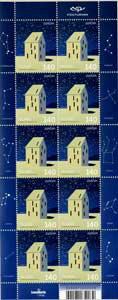
Iceland 140 value in mini sheet form with constellations in the selvage - note the difference between the two "skies" on the stamps that tranfers to the mini sheets - one with a day sky and the other with a night sky.
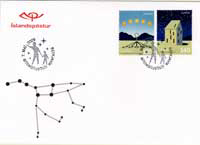
FDC from Iceland that carries both stamps, cache art of a constellation (Ursa Major) and a postmark reflective of the IYA 2009 logo.
07May2009: Italy - EUROPA issue
Poste Italiane - Europa 2009 ~ Astronomy issue
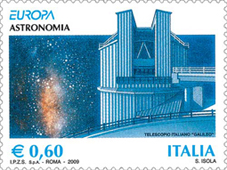
Italy - Europa 2009 ~ Astronomy issue: two designs issued. One stamp valued at € 0,60 (shown here) depicts the Italian "GALILEO" telescope facility set against a nebula, while the other valued at € 0,65 depicts the astronomical satellite "AGILE."
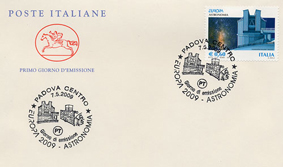
Italy - Europa 2009 ~ Astronomy issue: € 0,60 FDC.
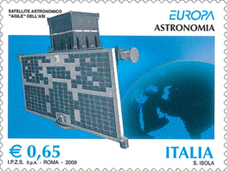
Italy - Europa 2009 ~ Astronomy issue: two designs issued. One stamp valued at € 0,60 depicts the Italian "GALILEO" telescope facility, while the other valued at € 0,65 (shown here) depicts the astronomical satellite "AGILE" above the Earth.

Italy - Europa 2009 ~ Astronomy issue: € 0,65 FDC.
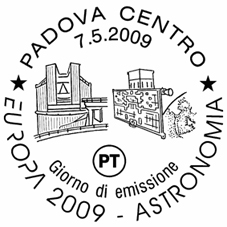
Italy - Europa 2009 ~ Astronomy issue: Postmark used on the FDCs for the Italian releases.
07May2009: Moldova - EUROPA issue
Poşta Moldovei - Europa 2009 ~ Astronomy issue
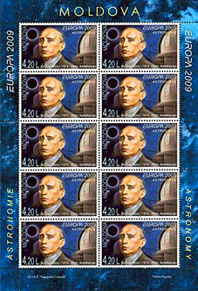
Moldova - Europa 2009 ~ Astronomy issue: The 4.20 MDL value in mini sheet of 10.
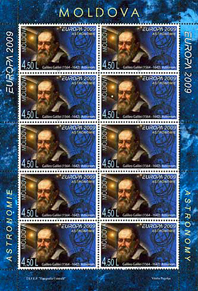
Moldova - Europa 2009 ~ Astronomy issue: The 4.50 MDL value in the mini sheet form.
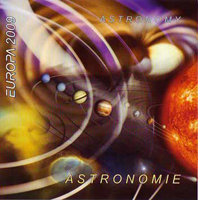
Moldova - Europa 2009 ~ Astronomy issue: Cover of booklet containing 6 of the stamps (3 stamps of each). (*)Note that an unperforated version has also been issued! The cover depicts our solar system.
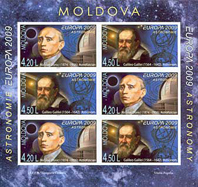
Moldova - Europa 2009 ~ Astronomy issue: two stamps (4.20 & 4.50 MDL) on page from the booklet of 6 stamps (3 stamps of each). These are the imperforate version.
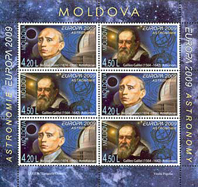
Moldova - Europa 2009 ~ Astronomy issue: two stamps (4.20 & 4.50 MDL) on page from the booklet of 6 stamps (3 stamps of each). These are the perforated version.
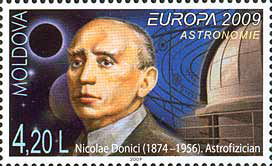
Moldova - Europa 2009 ~ Astronomy issue: two stamps (4.20 & 4.50 MDL) the 4.20 MDL value (shown here) depicts Nicolae Donici (1874-1956) a Romanian astronomer, an image of a solar eclipse, an observatory and an astronomical diagram.
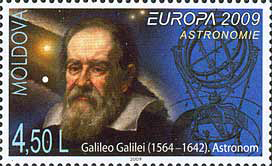
Moldova - Europa 2009 ~ Astronomy issue: The 4.50 MDL value (shown here) depicts Galileo Galilei (1564-1642) along with an armillary sphere and an image from space.
08May2009: Aland - EUROPA issue
POSTEN ÅLAND - Europa 2009 ~ Astronomy issue
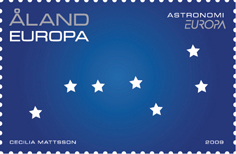
One design featuring the Big Dipper (or Karlavagnen) formed by star-shaped perforations made through the stamp.
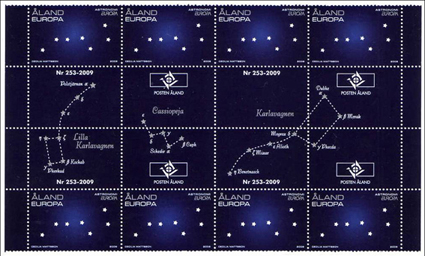
A sheet from the Åland release with (8) stamps seperated by a series of se-tenant labels featuring Posten Åland logo and three constellations - (from left to right) the Little Dipper, Cassiopeia and the Big Dipper. The two dippers are better known as the Plough and the Little Plough in the British Isles, while in Scandinavian the two are known by the name Karlavagnen which is derived from the even earlier Carlswæn and the historical names continue even further back and vary greatly by region.
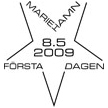
Postmark used for Aland release FDI.
08May2009: Azores - EUROPA issue
CTT Correios - Europa 2009 ~ Astronomy issue
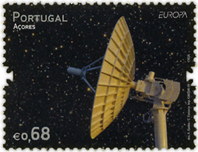
Azores stamp valued at 0.68 EUR and featuring a radio dish.
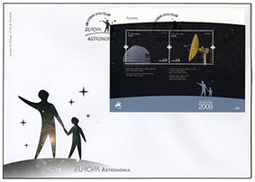
Azores FDC with souvenir sheet.
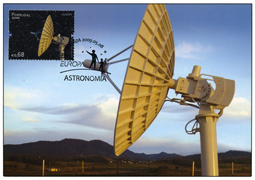
Portugal/Azores MaxiCard with FDI cancel.
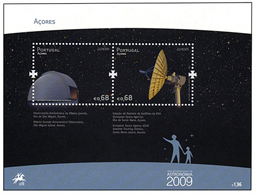
Portugal/Azores souvenir sheet with two stamp designs: one features the Ribeira Grande Astronomical Observatory and one with a radio dish, both valued at 0.68 EUR. An interesting note regarding the three Portugal issues - the souvenir sheets from Portugal, Azores and Madeira each contain a stamp that only is available on the souvenir sheet. Also of interest is the cross design incorporated in the perforations.
08May2009: Hungary - EUROPA issue
Magyar Posta - Europa 2009 ~ Astronomy issue
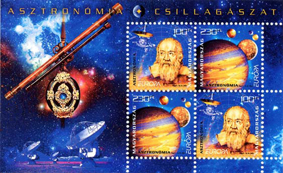
The Hungarian Post souvenir sheet and its stamps are decorated with graphic compositions. One denomination (the 100 HUF value) carries a portrait of Galileo and the spacecraft named after him. The other stamp (valued at 230 HUF) portrays the target of the "Galileo" probe, the planet Jupiter and four of its moons. In the selvage area of the sheet are featured the Galilean telescope, a radio telescope array and a background image of a region of the night sky as seen in "radio."
08May2009: Madeira - EUROPA issue
CTT Correios - Europa 2009 ~ Astronomy issue
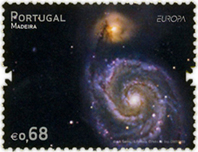
Madeira stamp valued at 0.68 EUR featuring a spiral galaxy M51.
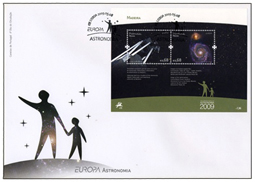
Madeira FDC with souvenir sheet.
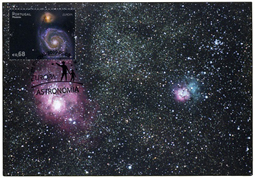
Madeira maxi card with FDI cancel.
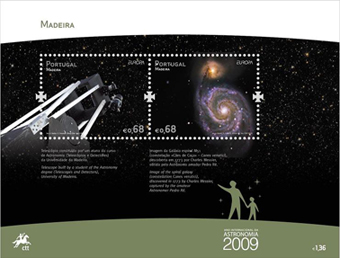
Madeira souvenir sheet with two stamps: each valued at 0,68 EUR. One features an image of a telescope and the other spiral galaxy M51.
08May2009: Portugal - EUROPA issue
(CTT) - Europa 2009 ~ Astronomy issue
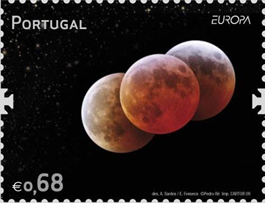
Portugal stamp valued at 0,68 EUR featuring total lunar eclipse montage.
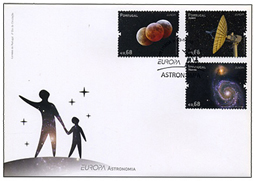
Portugal FDC featuring each of the three designs that fall under the Portuguese postal umbrella.
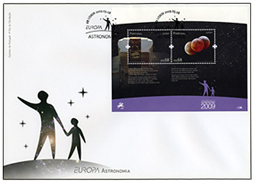
Portugal FDC with souvenir sheet.
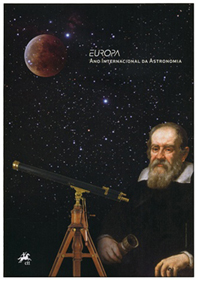
Cover of the release brochure containing infomation about the stamps as well as the stamps themselves. An interesting element is the transparency of the Moon, exposing the stars it overlays. Also featured are a telescope and portrait of Galileo.
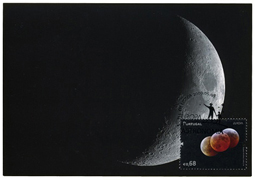
Portugal maxi card with FDI cancel. Notice the positioning required in order for the postmark to be visible against the card's image of the Moon.
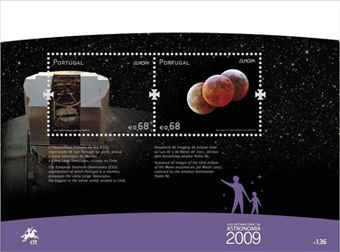
Portugal souvenir sheet with two stamps, each valued at 0,68 EUR. One design features one unit of the European Southern Observatory (ESO) "Very Large Telescope" (VLT) located in Chile - the largest in the world. The other design features mutiple views of the stages of a total lunar eclipse.
08May2009: San Marino - EUROPA issue
Azienda Autonoma di Stato Filatelica e Numismatica - Europa 2009 ~ Astronomy issue
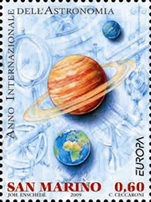
San Marino - Europa 2009 ~ Astronomy issue: two stamps (0.60 & 0.65 ¤) Both stamps feature illustrations reflective of an astronomy theme. This stamp (valued at 0,60¤) celebrates a historical route which has always seen man occupied in the understanding of the motion of the planets found in the universe around us, and just as curious to understand the laws which regulate the movement and the origin of such complex beauty. From the most rudimentary of telescopes used by Galileo Galilei (represented above on the left hand side of the stamp) to our most modern and sophisticated telescopes, human intelligence has strived to supply clear answers to the many questions which, over time, have brought the planets, the sun and the other stars nearer to us. The core element of this stamp is a celestial body, the main element of interest in astronomy, a satellite, much smaller, but studied just as thoroughly by scientists, and the Earth, where the continents and the oceans can be perceived. Preceding text courtesy of San Marino AASFN.
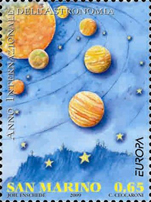
San Marino - Europa 2009 ~ Astronomy issue: two stamps (0.60 & 0.65 ¤) Galileo's discoveries in 1609 changed man's perception of the world and the universe: the lunar mountains revealed that another planet had geographic landforms and structures similar to those on Earth; the Milky Way is made up of stars; Jupiter has satellites like the Earth, which represented the system on a small scale, making obsolete the cosmological models used up until that time. The ¤ 0,65 stamp represents the solar system with all the planets in orbit around the sun, according to the heliocentric system hypothesized by Galileo Galilei, one of the first scientists to clash with the geocentric theory upheld by influential thinkers and illustrious theologians of the past. The twelve stars, symbol of the European flag, encircle the whole illustration and are the call for an international commitment to continue with the observation of the planets and widen the sphere of research and learning. Mount Titan, present at the bottom of the design, is perceived as the symbol of the Republic's participation and consent regarding future space exploration. Preceding text courtesy of San Marino AASFN.
08May2009: Switzerland - EUROPA issue
Swiss Post - Europa 2009 ~ Astronomy issue
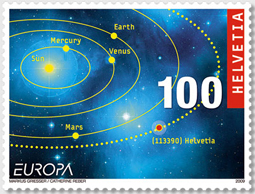
Switzerland - Europa 2009 ~ Astronomy issue: One stamp, depicting diagram of inner solar system with Sun and orbital paths of Mercury, Venus, Earth, Mars and asteroid "Helvetia."
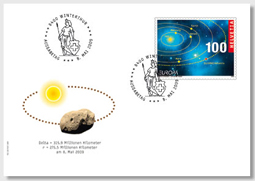
Switzerland - Europa 2009 ~ Astronomy issue: FDC featuring cache art depicting asteroid "Helvetia."
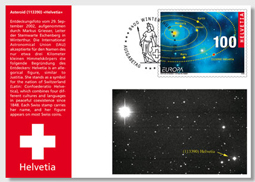
Switzerland - Europa 2009 ~ Astronomy issue: Maxi card.
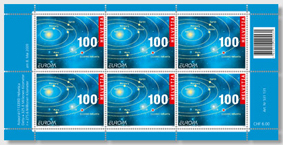
Switzerland - Europa 2009 ~ Astronomy issue: mini sheet of six stamps.
09May2009: Croatia - EUROPA issue
Croatian post Inc. - Europa 2009 ~ Astronomy issue
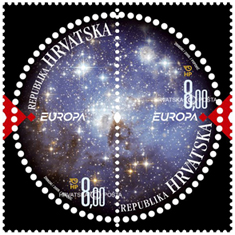
Croatia - Europa 2009 ~ Astronomy issue: 2 stamps (2x 8.- HRK) in an unusual format. The stamps are joined as a single se-tenant design of a star field. Each stamp forms one half of the design. But the format is that of a round stamp.
09May2009: Kosovo - EUROPA issue
PTT of Kosovo - Europa 2009 ~ Astronomy issue
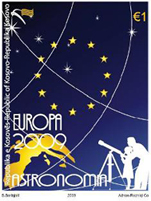
Kosovo - Europa 2009 ~ Astronomy issue: two stamps and one souvenir sheet depicting illustrations in celebration of the IYA2009. This stamp, valued at 1 EUR depicts the star circle logo from the flag of the European Union, a diagram of the "member" region of the globe and an adult directing the viewing session of a child.
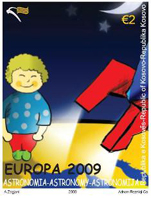
Kosovo - Europa 2009 ~ Astronomy issue: two stamps and one souvenir sheet depicting illustrations in celebration of the IYA2009. This stamp, valued at 2 EUR appears to be pulled directly from the souvenir sheet with the exception of the border.
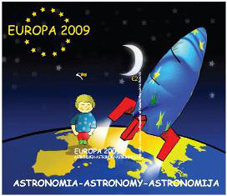
Kosovo - Europa 2009 ~ Astronomy issue: two stamps and one souvenir sheet depicting illustrations in celebration of the IYA2009. This souvenir sheet contains the image that was apparently pulled to create the stand alone 2 EUR stamp. However, the design on the souvenir sheet version extends into the surrounding overall design that is obviously directed toward the next generation of space explorers.
09May2009: Malta - EUROPA issue
Maltapost pl - Europa 2009 ~ Astronomy issue
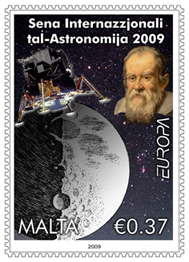
Malta - Europa 2009 ~ Astronomy issue: 2 stamps (0.37 & 1.19 €) The stamps are printed on Maltese Crosses watermarked paper by Printex Limited and are available in sheets of ten. The Euro 0.37 stamp (pictured here) features a portrait of Galileo Galilei (1564 - 1642) by Francesco Boschi and one of Galileo's sketches of the moon set against a starry background including the constellation Orion. The stamp also commemorates the 40 year anniversary of the first manned lunar landing by featuring the Apollo 11 lunar module "Eagle". On 20 July 1969 Neil Armstrong was the first man to step on the moon, saying "That's one small step for (a)man, one giant leap for mankind". The font used (Futura) is the same as that used in the plaque which was attached to the lunar module: "Here men from the planet Earth first set foot upon the Moon, July 1969, A.D. We came in peace for all mankind".
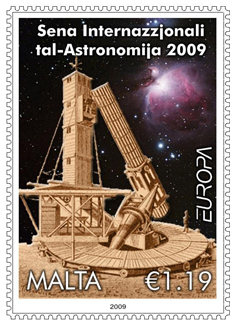
Malta - Europa 2009 ~ Astronomy issue: 2 stamps (0.37 & 1.19 €) The stamps are printed on Maltese Crosses watermarked paper by Printex Limited and are available in sheets of ten. The Euro 1.19 stamp (pictured here) shows the great telescope of William Lassell (set up in Malta between 1861 and 1865) against a background of stars showing Nebula M42, which Lassell himself observed on various occasions from Malta. This instrument, the world's largest telescope of its kind at the time, was a Newtonian reflector. Its tube was made of an iron lattice with ribs fitted at equidistant spaces. This design was suitable to compensate and stabilise expansions due to the difference in internal and external temperatures of the telescope. To be able to operate his telescope a wooden tower with a built-in stair case was constructed adjacent to it, to give Lassell the space he needed to make his observations at any desired position. This telescope was driven by two Maltese workmen with the aid of gear wheels which had to be operated by hand. William Lassell collaborated with Albert Marth who was a professional astronomer in Ireland and amongst Lassell's discoveries from his gigantic telescope in Sliema, are six hundred nebulae and the variable star ÔSÕ Pegasi. When Lassell returned to England in he offered his reflector telescope to other observatories but in spite of its excellent quality it was finally broken up for scrap in 1877. This marked the end of an era. Lassell died in 1880. Ten years before William Lassell had been elected president of the Royal Astronomical Society and the University of Cambridge had awarded him with the honorary LL.D. degree. Two moon craters were named after Marth and Lassell. William Lassell's crater is found adjacent to Mare Nubium and Albert Marth's crater is situated near the edge of Mare Humorum.
09May2009: Turkey - EUROPA issue
PTT Genel Müdürlüğü - Europa 2009 ~ Astronomy issue: 2 stamps (0.80 & 1.- YTL)
11May2009: Armenia - EUROPA issue
Haypost - Europa 2009 ~ Astronomy issue
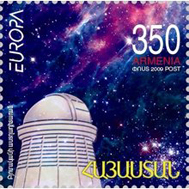
Stamp from Armenia, date of Issue: 11th May 2009 - one stamp, valued at 350.- AMD. The stamp design features the Byurakan Astrophysical Observatory, founded in 1946, set against an image that appears to be some deep sky object.
11May2009: Bosnia and Herzegovina - EUROPA issue
JP BH POSTA - Europa 2009 ~ Astronomy issue
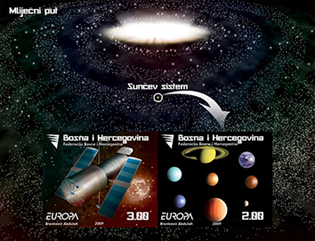
Bosnia and Herzegovina - Europa 2009 ~ Astronomy issue: The souvenir sheet incorporates the two stamp designs into a sheet that illustrates our Milky Way galaxy and our very small part within it.
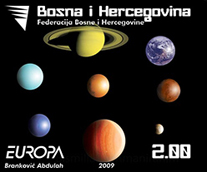
Bosnia and Herzegovina - Europa 2009 ~ Astronomy issue: Two stamps and souvenir sheet. This stamp illustrates the members of our solar system.
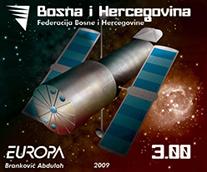
Bosnia and Herzegovina - Europa 2009 ~ Astronomy issue: This stamp illustrates a space telescope (Hubble?) and a distant target for observation.
11May2009: Greece - EUROPA issue
Ελληνικά Ταχυδρομεία - Hellenic Post - Europa 2009 ~ Astronomy issue
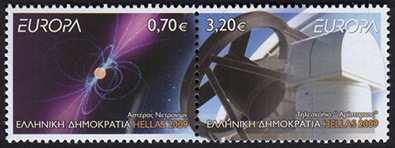
Greece - Europa 2009 ~ Astronomy issue: 2 stamps (0.70 & 3.20 €) The two stamps form an se-tenant design depicting the "Aristarchos" telescope and an illustration of the dynamics of a pulsar. The telescope was named after Aristarchos of Samos, the first reported person pondering about heliocentrism, the Greek telescope with a primary mirror diameter of 2.3 m and a final focal ratio f/8 is the pride of the Institute of Astronomy and Astrophysics (IAA) of the National Observatory of Athens (NOA), being the largest one in the southeastern Europe. The telescope received "first light" on 15 September 2004.
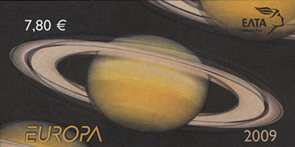
Greece - Europa 2009 ~ Astronomy issue: 2 stamps (0.70 & 3.20 €) The cover of a booklet form of the Greek release depicting images of the planet Saturn. The 7.80 € price reflects the fact that the booklet contains two se-tenant pairs of the stamps inside.
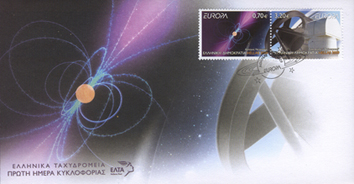
Greece - Europa 2009 ~ Astronomy issue: 2 stamps (0.70 & 3.20 €) The "official" First Day Cover with its artwork pulled directly from the stamp design ... quite a handsome presentation.
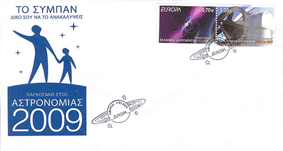
Greece - Europa 2009 ~ Astronomy issue: 2 stamps (0.70 & 3.20 €) Both stamps on a FDC featuring the IYA2009 logo as the cache art. The special postmark is perhaps derived from the planet Saturn.
12May2009: Luxembourg - EUROPA issue
Post Luxembourg - Europa 2009 ~ Astronomy issue
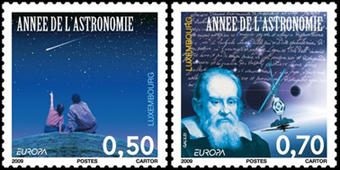
Luxembourg - Europa 2009 ~ Astronomy issue: two stamps (0.50 & 0.70 €) Both stamps are issued in mini-sheets of 10 stamps. The two stamp designs . . . one (the 0.50 value) depicting a father and child sitting in the grass and observing the night sky, and a shooting star, while the other (the 0.70 value) will depict a portrait of Galileo (with his telescope) on an artistic background. Both stamps will have the text "year of astronomy" (in french) included as a design element. THE FOLLOWING TEXT COURTESY OF POST LUXEMBOURG: "UNESCO has proclaimed the year 2009 'International Year of Astronomy'. This year is the 400th anniversary of the first observations made by Galileo with the aid of a telescope. P&TLuxembourg commemorates this event by issuing 2 stamps. Astronomy, the oldest of the sciences, is also considered the 'Queen' of sciences. The first men who left their caves studied the sky and adapted their way of life to the motion of the sun, moon, and stars. In ancient times, entire states were organized along astronomical concepts and we know of places and objects dedicated to this science. This is the perfect time to rediscover the sky with our fellow citizens and to help make the sky more visible with reduced lighting. Constellations such as the Ursa Major and Ursa Minor, Cassiopeia, Orion as well as stars and planets such as Polaris, Sirius, Venus, Jupiter, Saturn and Mars should once again become part of our general culture. To attain this objective is the true goal of this exceptional year."
15May2009: Ireland - EUROPA issue
Irish Stamps - Europa 2009 ~ Astronomy issue
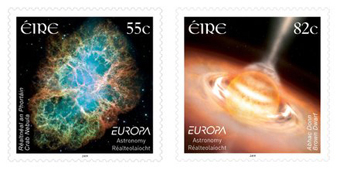
Ireland - Europa 2009 ~ Astronomy issue: 2 Stamps: One valued @ 0.55c which features the Crab Nebula & the other valued @ 0.82c features an artist's impression of the jets streaming from a brown dwarf. Both stamps from this issue feature areas of astronomy of particular significance for Ireland. The 55c depicts the Crab Nebula (an object first observed in 1731 by the English astronomer, John Bevis) which was named by William Parsons, the Third Earl of Rosse, based on observations made from within Ireland at Birr Castle, Co Offaly. The Crab Nebula's ranking as the brightest and most recent supernova near our Earth, could lend credence to the claim that it is the most studied object in the night sky. The 82c stamp depicts an artist's impression of energetic jets emitting from a Brown Dwarf. Such objects are sub-stellar bodies considered not quite suns but not quite planets. Their intermediate classification is derived from the fact that their mass is less than that of a star but greater than that of the largest planets. Much research is currently underway and on Brown Dwarfs and Irish astronomers are taking a leading role.
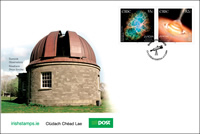
Ireland - Europa 2009 ~ Astronomy issue: 2 Stamps: FDC from the Irish issue. It carries both stamps, a special postmark and cache art depicting the Dunsink Observatory.
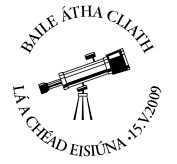
Ireland - Europa 2009 ~ Astronomy issue: Postmark depicting a telescope used for the Irish releases FDCs.
15May2009: Morocco - IYA2009 issue
Poste Maroc - IYA 2009 ~ Astronomy issue
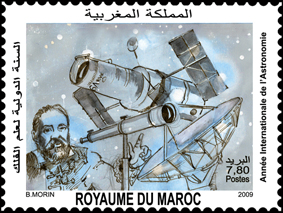
Morocco - IYA 2009 ~ Astronomy issue: An illustration depicting Galileo and three telescopes - a small optical instrument, a radio dish and space based platform.
20May2009: Vatican - EUROPA issue
Vatican Philatelic and Numismatic Office - Europa 2009 ~ Astronomy issue
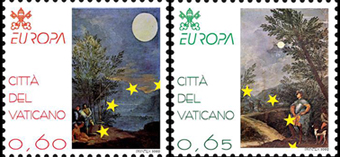
Vatican - Europa 2009 ~ Astronomy issue: 2 stamps ( € 0.60 - 0.65) showing two oil paintings by Donato Creti - Saturn and The Sun. The 18th century works from the Pinacoteca of the Vatican Museums are an eight-part series of small format paintings (50 x 35 cm) called "Astronomical Observations."
25May2009: Faröe Islands - EUROPA issue
Postverk Føroya - Europa 2009 ~ Astronomy issue
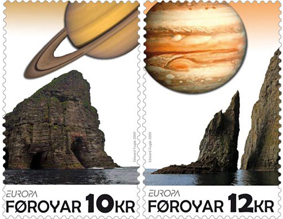
Faröe Islands - Europa 2009 ~ Astronomy issue: 2 Stamps. Both stamps feature seascapes from the region. The 10 KR value includes the planet Saturn while the 12 KR value includes Jupiter.
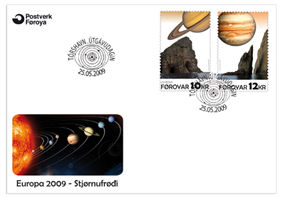
Faröe Islands - Europa 2009 ~ Astronomy issue: FDC from Faroese issue containing the two stamps, a special postmark of a diagram of the solar system and cache art of the Sun and planets.
28May2009: Guernsey - EUROPA issue
Guernsey Post Ltd. - Europa 2009 ~ Astronomy issue: Set of 6 stamps £3.17, FDC £3.97, Presentation Pack £3.97, Sheets of 10 £31.70
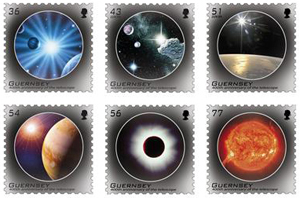
Guernsey - Europa 2009 ~ Astronomy issue: Set of 6* stamps, FDC, Presentation Pack and in sheets of 10 (*) only two of the six stamps in this set will carry the official EUROPA logo. The six stamps offer the collector a variety of astronomical images that include the Sun, a total solar eclipse, Jupiter and three rather mysterious images which one might develop their own interpretation of ...
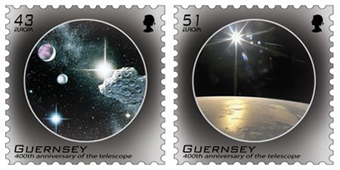
Guernsey - Europa 2009 ~ Astronomy issue: Set of 6* stamps - (*) only two of the six stamps in this set will carry the official EUROPA logo. These are those two, the 43 and 51 values.
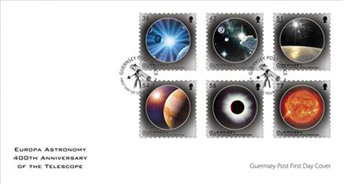
Guernsey - Europa 2009 ~ Astronomy issue: Set of 6 stamps on FDC with special "telescope" design postmark.
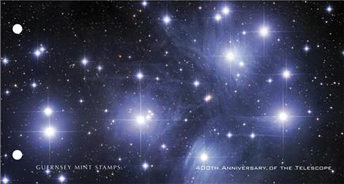
Guernsey - Europa 2009 ~ Astronomy issue: This cover for the Guernsey presentation pack has an image of the Pleiades.
28May2009: Slovakia - EUROPA issue
Slovenská Pošta (Pofis) - Europa 2009 ~ Astronomy issue
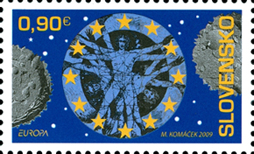
Slovakia - Europa 2009 ~ Astronomy issue: One stamp valued at 0.90 EUR depicts a semblance of Leonardo Da Vinci's "Measure of Man" image inscribed within the star circle of the flag of the European Union. The two design elements that flank the figure on either side may be images of meteorites.
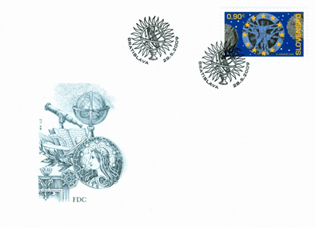
Slovakia - Europa 2009 ~ Astronomy issue: FDC from Slovakia issue with fanciful cache art work and a special postmark of a flaming armillary.
29May2009: Democratic Republic of São Tomé and Príncipe - IYA2009 issue
Stamparija, UAB - IYA 2009 ~ Astronomy issue
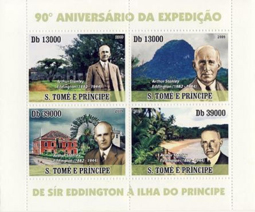
Democratic Republic of São Tomé and Príncipe - IYA2009 ~ Astronomy issue: Miniature sheet marking the 90th anniversary of the 1919 solar eclipse expedition of Sir Arthur Stanley Eddington (1882-1944) to Principe. Composed of four stamps (2x Db 13000 + 2x Db 39000 values) Various images of Eddington set against various locales in the region. Eddington's observations of the 1919 eclipse are considered to be one the greatest moments in scientific history of the twentieth century having provided proof of Einstein's theory of general relativity, which predicted a shifting of the observed position of stars when under the influence of strong gravitational fields.
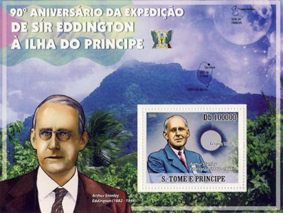
Democratic Republic of São Tomé and Príncipe - IYA2009 ~ Astronomy issue: Souvenir sheet marking the 90th anniversary of the 1919 solar eclipse expedition of Sir Arthur Eddington to Principe. Sheet features Moon, portrait of Addington and map of region. Inset stamp features portrait of Addington and image of total solar eclipse. Stamp is valued at Db 100000
29May2009: Slovenia - EUROPA issue
POŠTA SLOVENIJE - Europa 2009 ~ Astronomy issue
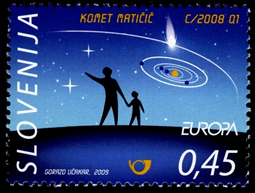
Discovery of the Comet C/2008 Q1 (Maticÿicÿ) in the Astronomical Observatory in Cÿrni Vrh: The Observatory at Cÿrni Vrh has been preparing a programme of discovering comets and asteroids PIKA for several years. More than 400 small objects were discovered in our solar system in the framework of this programme, as well as six supernovae. Recently there was another successful discovery. On CCD pictures which were taken in the framework of the Project PIKA on the evening of August 18th 2008 with a 60-cm telescope Cichocki in the Observatory in Cÿrni Vrh, Stanislav Maticÿicÿ found a weak object with an unusual movement. A detailed examination of the recordings made the previous night showed that this was a foggy object with central condensation. The day afterwards, on August 20th 2008, the discovery was published in the circular of the International stronomical Association. Soon it was also confirmed by other Observatories around the world.. The Comet was named after the person who discovered it: C/2008 Q1 Maticÿicÿ. This is the first, and so far the only comet discovered during observations in Slovenia. The stamp stylistically shows the relative position of the Sun, Mercury, Earth, Mars and the Comet C/2008 Q1 Maticÿicÿ at the moment of its discovery. Dr. Andreja Gombo
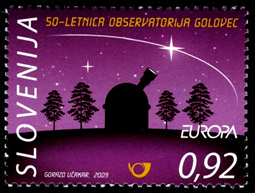
50th anniversary of the Astronomical and Geophysical Observatory Golovec: In the year 2009, 50 years have passed since Slovenia got its first astronomical observatory in a modern sense of the word. The Astronomical and Geophysical Observatory Golovec in Ljubljana was established on the initiative of Prof. Fran Dominko. In the early stages of the Observatory the first Slovene astronomical library was established, methods of measurement of classical astronomy were introduced, the geographical position of the Observatory was determined accurately, the service of accurate time was introduced and the publication of astronomical phemerides began. The Observatory also had seismological instruments which enabled the development of seismological work in the Observatory under the direction of Prof. Dr. Vladimir Ribaricÿ. Nowadays, the astronomical part of the Observatory performs mainly only a pedagogical function due to the light pollution which is the problem of many European Observatories. It is a part of the Faculty of Mathematics and Physics in Ljubljana and numerous generations of students of astronomy, physics and mathematics have written observation Projects and Theses in it. Since 2004 it has been equipped with a modern 70-cm Vega telescope. The Observatory also has a large astronomical library. In 2009 the Observatory is open to visitors every first Wednesday in the month. Dr. Andreja Gomboc
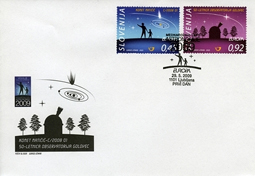
FDC with both values. The cache art, special cancel and 0,45 value all carry the logo from the IYA2009.
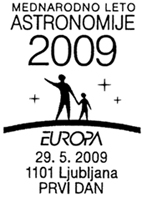
Special FDI postmark incorporating the IYA2009 logo.



